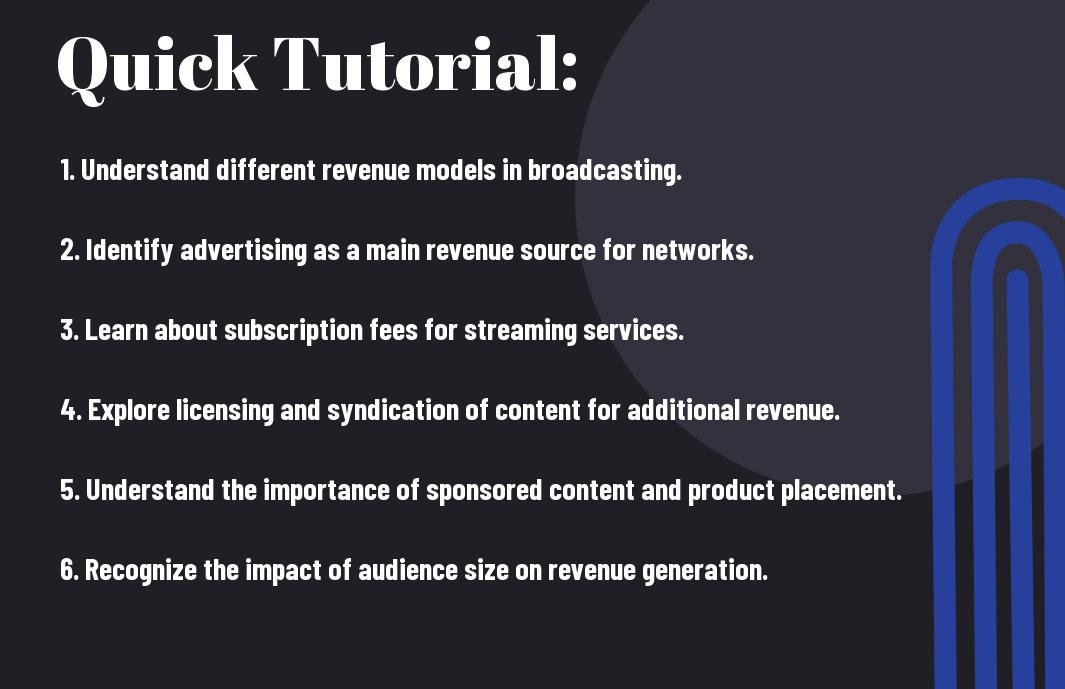How Do Networks Make Money – Understanding Revenue Models in Broadcasting
- Home
- How Do Networks Make Money – Understanding Revenue Models in Broadcasting

How Do Networks Make Money – Understanding Revenue Models in Broadcasting
Perusing through the intricate mechanisms of broadcasting revenue models can often be overwhelming, but fear not, as I am here to guide you through the intricate web of earning potential. Understanding how networks make money in broadcasting is crucial for anyone interested in the industry, whether you’re a media professional or a consumer. In this tutorial-style blog post, I will break down the most important revenue models that networks use, from advertising to subscription services, and how they affect the content you see on your screen. By the end of this post, you will have a comprehensive understanding of the financial side of broadcasting, giving you valuable insights into the inner workings of the industry.
Key Takeaways:
- Diversified Revenue Streams: Networks make money through a variety of sources including advertising, subscription fees, syndication, and content licensing.
- Ad-based Revenue Model: Advertising remains a primary revenue driver for networks, with ad sales based on viewership and demographics.
- Subscription and Pay-Per-View Models: Some networks generate revenue through subscription fees or pay-per-view events, offering exclusive content to paying customers.
- Content Licensing and Syndication: Networks earn money by licensing their content to other platforms and media outlets, as well as through syndication deals with local and international broadcasters.
- Digital and International Expansion: Networks are utilizing digital platforms and expanding internationally to tap into new revenue streams and reach a global audience.
Revenue Models in Broadcasting
For broadcasters, generating revenue is essential for the sustainability and growth of their operations. There are several revenue models in broadcasting, each with its own strengths and challenges. Understanding these models is crucial for anyone interested in the broadcasting industry.
Advertising
Advertising is a primary source of revenue for many broadcasters. Advertisers pay to have their products or services featured during programming, and broadcasters make money based on the number of viewers reached and the duration of the ad slots. One of the major benefits of advertising revenue is its potential for high profits, especially if the programming attracts a large and engaged audience. However, reliance on advertising can also make broadcasters vulnerable to fluctuations in the economy and changes in consumer behavior.
Subscription
Subscription-based revenue models require viewers to pay a regular fee to access content. This can include cable or satellite television subscriptions, streaming services, or paywalls on websites. One of the advantages of this model is its predictability and stability of income, as broadcasters can rely on a steady stream of revenue from subscribers. However, attracting and retaining subscribers can be challenging, particularly in a competitive market where viewers have many options for accessing content.
Pay-per-view
Pay-per-view models allow viewers to access specific content for a one-time fee. This is commonly used for special events, such as sports matches or live concerts. This model has the potential to generate substantial revenue from a single event, particularly if it is highly anticipated. However, the success of pay-per-view models is heavily dependent on the popularity of the content being offered, and there is always a risk of not attracting enough viewers to make it financially viable.
Sponsorship
Sponsorship involves partnering with businesses or organizations that provide financial support in exchange for visibility and association with the broadcaster’s content. Sponsorship can be a lucrative revenue stream, especially if the broadcaster can offer exposure to a desirable target audience. However, finding the right sponsors and maintaining ongoing relationships can be time-consuming and challenging.
Understanding the Role of Networks
Assuming you have ever wondered how networks make money, it is important to understand their role in the broadcasting industry. Networks play a crucial role in the production, distribution, and targeting of content to specific audiences. This allows them to generate revenue through various business models.
Content Creation
Content creation is a core function of networks, and it involves the development and production of television shows, news programs, and other forms of media. This process requires significant investment in talent, resources, and production facilities. However, it is a high-risk, high-reward venture as successful shows can drive advertising revenue and viewer loyalty. Additionally, networks may also produce content for streaming services, further expanding their revenue potential.
Distribution
Networks are responsible for distributing their content to various platforms, including cable and satellite providers, streaming services, and international markets. This involves negotiating distribution deals and licensing agreements, which can be a complex and contentious process. However, successful distribution is essential for reaching a wide audience and maximizing revenue potential.
Audience Targeting
Networks utilize audience targeting to attract advertisers and generate revenue. By understanding the demographics, interests, and behavior of their viewers, networks can deliver highly targeted advertising that commands premium rates. This not only benefits the network but also provides value to advertisers by reaching the right audience with their messaging.
Maximizing Revenue
Now that we understand the basic revenue models in broadcasting, let’s delve into how networks can maximize their revenue. It’s crucial for broadcasters to diversify their revenue streams and utilize digital platforms effectively to increase their earnings.
Diversification of Revenue Streams
One of the most important strategies for networks to maximize their revenue is to diversify their revenue streams. This involves not relying solely on traditional advertising revenue, but also exploring other sources such as subscription fees, licensing content, merchandise sales, and live events. By diversifying revenue streams, broadcasters can reduce their dependence on a single source of income, thereby mitigating the risk of financial instability. Moreover, diversification allows networks to tap into new and lucrative markets, ultimately boosting their overall revenue.
Utilizing Digital Platforms
In today’s digital age, leveraging digital platforms is essential for broadcasters to maximize their revenue. I believe that by embracing streaming services, social media, and digital advertising, networks can significantly expand their reach and engage with a broader audience. Furthermore, digital platforms offer various monetization opportunities, such as pay-per-view content, targeted advertising, and sponsored content. By capitalizing on digital platforms, networks can not only generate additional revenue but also adapt to the changing media landscape and stay competitive in the market.

Conclusion
With this in mind, understanding the various revenue models in broadcasting is crucial for anyone looking to work in the field or simply wanting to understand how their favorite networks make money. From advertising to subscriptions and syndication, the broadcasting industry relies on a variety of revenue streams to stay afloat. By learning about these models, you can gain a better understanding of the complexities of the industry and how networks are able to produce the content we all enjoy. Whether you’re a viewer or a professional in the industry, having an awareness of these revenue models can provide valuable insight into the world of broadcasting.
FAQ
Q: What are the different revenue models used by networks in broadcasting?
A: Networks in broadcasting typically utilize advertising, subscription fees, and content licensing as their primary revenue models.
Q: How do networks generate revenue through advertising?
A: Networks generate revenue through advertising by selling airtime to companies looking to reach their audience. They charge advertisers based on factors such as the time of day, program popularity, and audience demographics.
Q: What is the role of subscription fees in network revenue models?
A: Subscription fees are a significant source of revenue for networks, particularly in the case of cable and streaming services. Viewers pay a monthly or annual fee to access the network’s content.
Q: How do networks make money through content licensing?
A: Networks make money through content licensing by selling the rights to their original programming to other networks, streaming platforms, or international broadcasters. This allows them to generate additional revenue from their content.
Q: What are some other sources of revenue for networks in broadcasting?
A: In addition to advertising, subscription fees, and content licensing, networks may also generate revenue from merchandise sales, live events, sponsorships, and partnerships. These supplementary sources contribute to their overall financial success.
- Share
Mark Twain
Mark Twain stands at the helm of Create More Flow, infusing every sentence with the wisdom of his 15-year expeience through the seas of SEO and content creation. A former BBC Writer, Mark has a knack for weaving simplicity and clarity into a tapestry of engaging narratives. In the realm of content, he is both a guardian and a guide, helping words find their flow and stories find their homes in the hearts of readers. Mark's approach is grounded in the belief that the best content feels like a chat with an old friend: warm, inviting, and always memorable. Let Mark's expertise light up your website with content that's as friendly to Google as it is to your audience. Each word is chosen with care, each sentence crafted with skill - all to give your message the human touch that both readers and search engines love.
